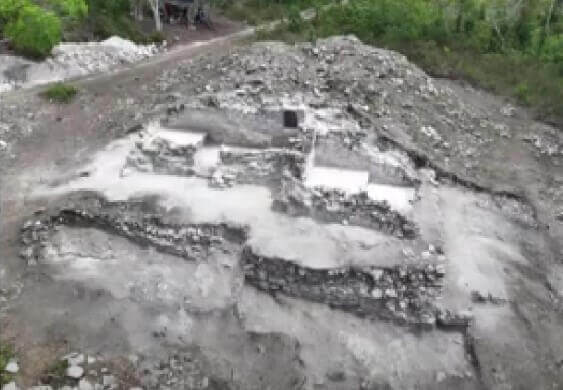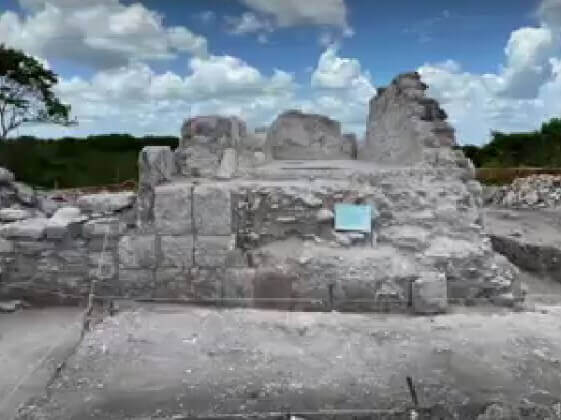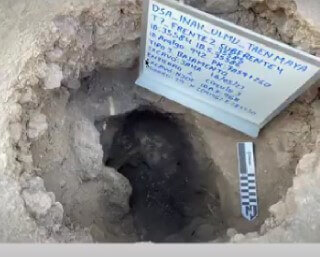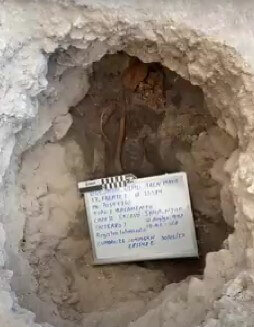Rescuing a Monumental “Citadel” in Section 7 of the Tren Maya
Ramón Enrique Carrillo





During the construction of Section 7, Front 2, of the Tren Maya, three monuments were discovered and relocated. Together, they form a site resembling a citadel, possibly dating to the Early Classic period (300-600 AD). This monumental rescue is part of the archaeological salvage efforts coordinated by Dr. Manuel E. Pérez Rivas, who leads a team of archaeologists, specialists in various fields, manual laborers, and specialized masons. The National Institute of Anthropology and History (INAH), the INAH Quintana Roo Center, and personnel from the Ministry of National Defense have made it possible to recover archaeological settlements previously unknown.
This group of structures, discovered during the first half of 2023, features well-defined stone walls, stuccoed interior walls, the presence of rooms, pottery findings, shell beads, and five burials. The “citadel” consists of the archaeological sites T7_36074, T7_35584, and T7_35066.
Of these sites, T7_36074 contains two rooms, each with a bench. The first room, located to the west, features a bench, a niche in the northeast corner of the north wall, and an entrance in the south wall. Its maximum height does not exceed one meter, but part of the structure was built directly on the bedrock. The second room, located to the east, contains only a bench and lacks an east wall, but it reaches a height of 1.80 meters. A notable feature of this site is the discovery of an adult burial beneath the bench in the eastern room, with a bowl placed on the skull. This burial adds to the total of five found within the “citadel.”
During the excavation of site T7_35584, supervised by archaeologist Jesús Alberto Hernández Almendarez, a room was identified in the southern area. Archaeologists observed the presence of circular openings, which turned out to be a series of burials. The first burial contained skeletal remains with dental modification on the incisors. The second burial was found at nearly the same depth within the same room, beneath what may have been a cist, though this was not confirmed. The skeleton was lying on its right side. A third burial was discovered one floor below, in a similar location. These remains were lying on their left side but were partially disturbed compared to the previous ones. Outside the room, in the northeastern end of the structure, near the adjacent monument in what appears to be a corridor, a fourth burial was found. This burial appeared to be secondary or relocated, as it lacked clear anatomical association and was positioned differently from the others.
In the same site, T7_35584, archaeologists also found various artifacts, including pot rims measuring between 15 and 40 centimeters in diameter, a fairly common discovery in settlements of the region. Shell beads were uncovered near the burial in the corridor of T7_35584, along with a fragment of an anthropomorphic figurine.
Finally, another notable feature of this site is the presence of two distinct architectural styles, suggesting that the structure underwent two construction phases. This indicates that part of the building was added after the original settlement was established. On the western side, an extension is observed on one of the walls, dividing the southern and northern sections. The southern section appears to be the oldest, as its construction limits are not clearly defined and it shows greater deterioration compared to the northern section.
dismantling to preserve
The excavation process was completed in June 2023, and five months later, the dismantling and relocation process began. This activity ensures the most faithful preservation of the archaeological remains and safeguards the historical memory of the Maya culture. The same methodology used for the rescue of other monuments within the archaeological salvage project was applied: staff orientation, marking and recording of stones, and dismantling.
Before beginning the technical process, INAH specialists provide lectures and guidance to the construction personnel and SEDENA members about the importance of carrying out this activity. This ensures that they understand its value and perform the work with extreme care.
Once the personnel has been trained, the marking and recording of the stones that make up the construction begins. Each stone is marked with an alphanumeric series using a lime solution. Following this, photographic and topographical records are taken to ensure precise references for the reassembly process.
Once the recording is completed, the dismantling of the monument begins. It is important to note that, simultaneously, additional photographic and topographical records are made every time a row of stones is finished.
Due to the presence of stuccoed interior walls in this monumental complex, the stones from these walls were carefully dismantled and arranged in a grid to ensure their proper location during reassembly. Another particular challenge encountered during the dismantling of the "citadel" was the niche in the western room of site T7_36074. The dismantling work of the sites was supervised by archaeologists Fernando Zais, Pablo Santana, and anthropologist Daniel Arriaga.
The dismantled monuments will be reassembled once the land designated for them is prepared. In this way, the INAH archaeological salvage project, in collaboration with the INAH Quintana Roo Center and SEDENA personnel, is rescuing the heritage of the Maya culture to continue inspiring present and future generations and to provide ongoing insights into their greatness.
